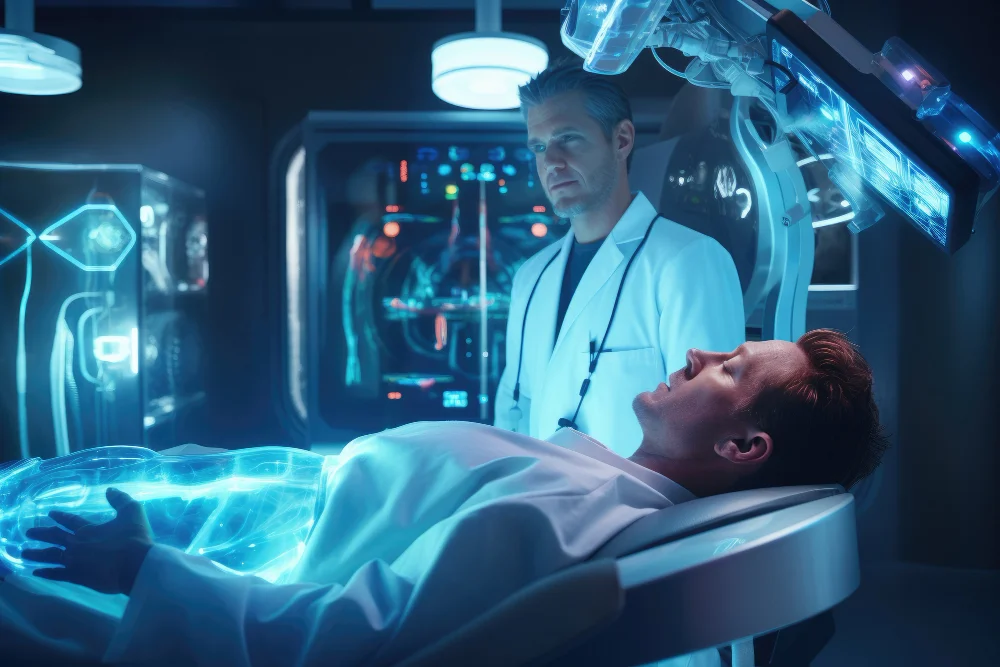Emergencies call for immediate responses, critical medical treatments, and collaboration between patients, paramedics, and hospitals. Traditional ambulances are essential to care delivery, but typically operate in information silos, isolated from real-time patient information, hospital resources, and urban environments. IoT Healthcare Solutions are paving the way for smart ambulances. Connected, intelligent, and ready to save patient lives before they even arrive at the hospital.
What is a Smart Ambulance?
A smart ambulance is a new type of emergency vehicle, equipped with sensor technology from the Internet of Things, cloud-connected systems, and communication-enabled devices that meet medical standards. Conventional ambulances have primarily been patient transporters, while smart ambulances serve as mobile emergency rooms; gathering vital signs, transferring them and letting specialists assist in real time from a location outside the hospital when needed.
Smart ambulances utilize IoT Application Development that ensure the entire picture is integrated and uses information for better patient care and traffic management.
The IoT Engine: Key Technologies Powering the Revolution
Vehicle-to-Everything (V2X) Communication
A V2X (Vehicle to Everything) capability allows ambulances to directly connect and communicate with urban road motion elements, like other vehicles, public users, traffic lights, and road sensors. When a smart ambulance arrives at a congested intersection, V2X signaling technologies will be able to indicate a change in the color of the traffic light to provide a clear passing option, enable a route assembly of oncoming vehicles, and notify the responsible public driver components. Overall, the incorporation of V2X technology allows ambulances to decrease transit interruptions for more straight and timely medical interventions.
- Allows for emergency real-time traffic prioritization at assignments and route optimization.
- Allows an early warning ceremony to other competing road user options to lessen the chance of collisions.
Advanced Patient Monitoring Sensors
More than 60% of ambulances currently have integrated sensors that continuously measure patient biologists vitals: ECG (Heart Monitoring), oxygen saturation after resuscitation, blood pressure, and body temperature. These sensors not only feed timely vitals to system screens inside the ambulance but also breastfeed data to three clinicians exercising telehealth supervision – badging the involved ER hospital staff and clinicians with informed stabilization proposals upon the patient’s arrival.
- Enables immediate diagnostic and assessment capabilities, engagement, and established medical actions and interventions by hospital staff.
- Supports emergency medical and hospital personnel to prepare teams and resources of immediate support by the metrics of the vital signs, in real-time.
On-Board Diagnostics and Asset Tracking
The IoT development services provide the use of fleet management, asset tracking, and equipment diagnostics in an ambulance. By leveraging GPS-enabled solutions, emergency planners will have the ability to manage the real-time location, condition, and status of every ambulance. This will reduce the threat of theft or unauthorized use of the ambulances, and guarantee optimal resource utilization in the event of an emergency.
- These services also provide a method of monitoring the health of the vehicle, tracking driver behavior, and usage patterns, as determined by the telemetry data reported by the vehicle.
- Resource utilization and operational efficiency is critical to deliver value in healthcare.
High-Bandwidth, Secure Connectivity (5G/LTE)
The modern smart ambulance’s high-speed and safe response to transmission of patient clinical data (for example blood pressure, glucose and ECG), video calls, and live sensor feedback between the ambulance, the cloud, and the hospital, relies on a stable internet connection via 5G or LTE. This allows for real-time telemedicine, real-time visual collaborative advising, and fast integration into the EHR.
- It guarantees secure and real-time channels with no missed information due to latency frames.
- Can provide data feeds with no time-lag to AR / VR tools for immersive specialty guidance and remote diagnosis from consulting medical experts.
How Information Flows in a Smart Ambulance Ecosystem
Smart ambulances act as nodes in a connected environment through an IoT Application Development ecosystem:
Step 1: Data capture from sensors and devices inside the ambulance
All immediate patient data can be captured (in real-time), such as pulse, oxygen, ECG, glucose, etc., using biomedical sensors and connected medical devices embedded in the ambulance.
Step 2: Secure, real-time transmission via 5G/LTE to the cloud and the hospital
The patient-related data streams through an ambulance, the patient tracking system, to their hospital ER teams and cloud databases real-time – for all clinicians and administrators to act concurrently.
Step 3: Hospital EHR integration: Patient data populates charts before arrival
Hospital IT systems consume live data into EHR charts; therefore, medical teams can know exactly what to expect and they can pre-design the rooms, medicines, and staff.
Step 4: Real-time telemedicine consultation with ER physicians and specialists
With high-bandwidth connections, paramedics consult with ER specialists and hospital-based specialists remotely using video and audio; and close the gap of uncertainty, allowing real-time collaboration with their experts.
Step 5: Data-driven decision support for paramedics on the scene
Cloud-based AI and medical decision support tools can leverage incoming sensor data and make real-time recommendations of treatments, drug dosages, or other interventions had with paramedics on scene.
IoT for Emergency Healthcare: Revolutionizing Response and Saving Lives
Reduced Response Times
With IoT, routing of emergency vehicles, controlling of traffic lights, and real-time fleet routing enables the nearest available ambulance to get to the scene faster by 1, 2, 3 minutes, consistently.
- Evidence indicated that the average GPS smart dispatch achieved arrival times of 7 – 10 minutes in dense urban settings.
- IoT traffic controls would provide coordination eliminating delays associated with congestion or construction.
Informed Paramedics
Paramedics on the vehicle would receive the current cloud-synced medical records, triage instructions, decision support for their specific patient’s condition.
- Continuous live communications with ER teams would allow paramedics to provide evidence-based care throughout the transport.
- Utilize AR headset to provide step-by-step medical procedures for unusual or complex cases.
Enhanced Hospital Preparedness
Once hospitals are notified of patient vitals and case information ahead of arrival, surgical, pharmacy, and ICU teams can prepare interventions as soon as the patient arrives.
- Integration with EHRs can ultimately allow for improved patient outcomes because the right resources will be available at the right time.
- Hospitals can also use predictive analytics to see real-time transport data and allocate available beds and staff appropriately.
Remote Expert Guidance
Not all paramedics can provide expertise to every scenario; however, IoT-enabled video calls and augmented reality overlays allow remote ER doctors or specialists to effectively guide the paramedic through critical procedures with high detail.
- B5G-enabled ambulances support low-latency video collaboration, which will help the remote doctor collect diagnostics and make decisions faster.
- Specialist consultations can also use virtual reality tools, so they are more accessible and applicable in remote or rural contexts.
Efficient Resource Allocation
It’s easier to minimise operational costs, and improve coverage of high-risk areas by effectively using fleet and asset tracking. This improves the use of ambulances and emergency equipment by tracking items that should not be in service and to avoid unnecessary theft due to overuse of non-emergency transport.
- Continuous IoT-based monitoring/trackers can alleviate unauthorized use and other theft of ambulances, equipment, items or vehicles.
- Dispatch systems that provide the real-time location and availability of vehicles means there are often no additional ‘wasted’ fuel trips, and minimizing wait times.
Real-World Case Studies: Smart Ambulances in Action Today
Northwell Health (New York)
Northwell Health has implemented smart ambulances that use real-time patient telemetry, cloud EHR/EMR, and telemedicine video for improved emergency response in New York.
Copenhagen EMS (Denmark)
Copenhagen EMS has IoT-enabled ambulances that utilize fleet tracking and high-performance data and communication capabilities to coordinate health resources across the entire city to expedite life saving response.
Dubai Corporation for Ambulance Services
Dubai has invested in smart ambulances with mobile clinics that continuously monitor patients, augmented reality and virtual reality for remote consultations, and receive automated notifications when patients arrive in the emergency department.
What’s Next for Emergency Response?
Integration with AI and Predictive Analytics
Integration with AI and Predictive Analytics – AI will drive risk stratification, optimize routes, and enable pre-arrival diagnostics, making emergency response increasingly predictive and personalized.
- AI-based triage and resource allocation will optimize outcomes, and reduce mortality.
- Historical IoT data will also drive preventative urban planning and outbreak identification.
Drones for Delivery
In the near future, medical drones will be fully operational in collaboration with ambulances and will deploy to emergency scenes ahead of the vehicles to provide supplies, blood units, and automated external defibrillators (AEDs).
Augmented Reality (AR) for Paramedics
By leveraging IoT connectivity with AR overlays, paramedics will not only rely on evolving emergency procedure literature, they will be able to follow on-screen visuals and actual interactive data (displayed in smart glasses or tablets), if and when the procedures call for it.
The Fully Autonomous Ambulance
Autonomous ambulances, driven by IoT-enabled navigation and diagnostics, will soon transport patients safely and efficiently without human drivers, and further reduce response times and errors.
Final Thoughts
The disruption of emergency healthcare is theoretical no longer, it is already happening, driven by advances in IoT Healthcare Solutions, and years of experience of IoT Development Services. As smart ambulances continue to improve by adding powerful sensors, connectivity, artificial intelligence, and augmented reality, the standard of emergency response will continue to elevate, making these vehicles important platforms for lifecare delivery, and laying the groundwork to deliver comprehensive hospital services in the streets. The future promises increased survival rates, efficiency and preparedness for all, led by the unstoppable advance of smart ambulance technology powered by IoT.


